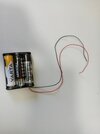Zestfully4
New Member
I have a pre-assembled DIY project I am working on for the sake of practice, and I'm perplexed as to how to power it on. Below is the schematic.
Based on it, VCC is on pin 7 of U2 and GND is on pin 2. However, the U2 component is not a typical IC as it's a board…
I have a 4.5V power source but can't seem to find a way to connect it to this circuit. I tried different combinations of red-black to one of the pads of the board and had no results. I'm a beginner student, so please be wary of that. Attaching circuit pictures from different sides below.

Based on it, VCC is on pin 7 of U2 and GND is on pin 2. However, the U2 component is not a typical IC as it's a board…
I have a 4.5V power source but can't seem to find a way to connect it to this circuit. I tried different combinations of red-black to one of the pads of the board and had no results. I'm a beginner student, so please be wary of that. Attaching circuit pictures from different sides below.








